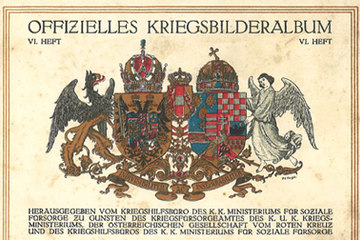Who photographed the war? Snapshooters, amateurs, front tourists
The mass spread and use of photographic technology led to a 'democratisation' of photography during the First World War – a phenomenon that was to characterise the 20th century.
Amateur photography underwent an unforeseen boom as a result of the war. Thanks to the invention of inexpensive roll film and hand-held cameras and developments in printing technology, the sale of cameras rocketed at the start of the war in 1914. In addition, the rise of the illustrated press encouraged the spread of photography, providing a visual framework for presenting the images. In this way, photojournalism began to establish itself as a separate field of business.
At the start of the war, the daily newspapers tried to outdo each other with the latest news from the war zones, and the demand for illustrations was huge. At the same time, photographs of the conflict were rare. There were as yet no officially accredited photographers, and only a few soldiers had taken cameras with them to the front. They began to do business with the photographs from the trenches, and soon amateur and professional photographers also travelled to the front in order to participate in the flourishing trade.
The way photographers were dealt with at the front varied very considerably in the warring countries. In Great Britain, for instance, the ordinary soldier was strictly prohibited from carrying a camera, and the entire front was subject to a stringent ban on photographs. In contrast, the army leadership in Austria-Hungary promoted photography at the front. Above all in the second half of the war, officers and soldiers were encouraged to record events on film and to send the photographs to the War Press Headquarters. Amateur photographers required authorisation from the relevant army command, which was issued for three months at a time. In return, the reimbursement of material costs was promised, with awards and prizes providing an additional incentive.
Amateur photographers were mobilised because the officially accredited photographers could no longer meet the increased demand for pictures. As a consequence, The War Press Headquarters under Wilhelm Eisner-Bubnas decided to reverse its strategy and to encourage the widespread production of images, while at the same time setting up a centralised censorship organisation for all images of the war. This decision marked a decisive turning point in the pictorial propaganda of the First World War.
Nevertheless, many soldiers continued to photograph 'their war' for those at home. The photographs served as an aid to memory and as a bridge for communication. They frequently showed an aspect of the war that was excluded from the official representations of the war. However, these images only became relevant in the post-war discourse, since they were rarely published and for this reason hardly known to a broader public.
Translation: David Wright
Carmichael, Jane: First World War Photographers, London/New York 1989
Holzer, Anton: Die andere Front. Fotografie und Propaganda im Ersten Weltkrieg, Darmstadt 2007
Hüppauf, Bodo: Fotografie im Ersten Weltkrieg, in: Spilker, Rolf/Ulrich, Bernd (Hrsg.): Der Tod als Maschinist. Der industrialisierte Krieg 1914–1918. Eine Ausstellung des Museums Industriekultur Osnabrück im Rahmen des Jubiläums „350 Jahre Westfälischer Friede“ 17.Mai-23.August 1998, Osnabrück 1998, 108-123
Von Dewitz, Bodo: Zur Geschichte der Kriegsphotographie des Ersten Weltkrieges, in: Roth, Rainer (Hrsg.): Die letzten Tage der Menschheit. Eine Ausstellung des Deutschen Historischen Museums, Berlin, der Barbican Art Gallery, London, und der Staatlichen Museen zu Berlin – Preußischer Kulturbesitz in Verbindung mit dem Imperial War Museum, London, Berlin 1994, 163-176
-
Chapters
- Public relations in the First World War: the state organisation for war reporting
- The WPH Photograph Office
- "Embedded photography": war photographers as part of military logistics
- Photography as a weapon: reconnaissance, surveying, documentation
- Who photographed the war? Snapshooters, amateurs, front tourists
- The canon of images of the First World War as reflected in the illustrated press
- The photographer as documentarian: the amateur's eye
- World War photography between traditional pictorial conventions and the Modern











